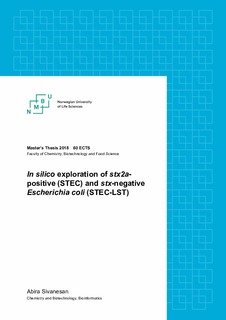| dc.contributor.advisor | Snipen, Lars | |
| dc.contributor.advisor | Bohlin, Jon | |
| dc.contributor.advisor | Brandal, Lin C.T. | |
| dc.contributor.author | Sivanesan, Abira | |
| dc.date.accessioned | 2019-03-26T14:40:57Z | |
| dc.date.available | 2019-03-26T14:40:57Z | |
| dc.date.issued | 2018 | |
| dc.identifier.uri | http://hdl.handle.net/11250/2591864 | |
| dc.description.abstract | Escherichia coli er en harmløs bakterie som naturlig sameksisterer med mennesker og dyr i tarmen. E. coli-genomet er dynamisk og kan skape store interne endringer (rekombinasjon), overføre plasmider (konjugasjon), tilegne seg DNA (transformasjon) og virus eller fager (transduksjon). Dette betyr at det finnes mange varianter av E. coli og at bakterien er vanskelig å analysere siden rekombinasjon og genetiske forandringer skjer fra generasjon til generasjon. Noen endringer er til fordel, som inkorporering av plasmider med antibiotikaresistens. Andre endringer kan være til skade, som integrasjon av en bakteriofag eller toksiner.
Det siste konseptet er av interesse når det omhandler shigatoksiner (Stx) produsert av shigatoksingener (stx). Toksinet observeres å bli overført mellom E. coli bakterier gjennom bakteriofager. Fagen er kartlagt ganske godt, men det er fortsatt karakteristisk informasjon som må avdekkes. Siden stx er veldig smittsomme for mennesker og dyr (som ofte er asymptomatiske), er det et behov for å forstå hvordan fagene overfører toksinene til E. coli.
I dette studiet er det av interesse å undersøke E. coli bakterier som er like. Noen E. coli i samme serogruppe med identisk multi-locus VNTR analyse-profil (MLVA-profil) produserer Stx, mens andre avstår. Siden stx er overført ved stx-fager, er det et behov for å analysere om det er rester fra fagen som kan ha forsvunnet fra genomet, eller andre varierende genetiske områder med spesifikke DNA-elementer hvor fager lett kan integreres. | nb_NO |
| dc.description.abstract | Escherichia coli is a harmless bacterium that naturally coexists with humans and animals in their intestinal tracts. The E. coli genome is dynamic and can make larger internal changes (recombination) like exchange plasmids (conjugation), add DNA (transformation) and virus or phages (transduction). This means that E. coli have many variants and are hard to analyze since recombination and genomic changes can happen from generation to generation. Some changes are beneficial, while others can be harmful. An example of a benefit could be incorporation of plasmids with antibiotic resistance genes, a disadvantage could be insertion of phages with toxins.
The last concept is of special interest regarding shiga toxins (Stx) produced by shiga toxin genes (stx). The toxin seems to be transferred between E. coli bacteria through bacteriophages. The phages are characterized relatively well, but there is still a lot of information left to reveal. Since stx is very infectious to humans and animals (often asymptomatic), there is a need to understand how the phages transfer these toxins to E. coli.
In this study there is an interest in researching E. coli bacteria that are similar. Some E. coli within the same serotype with identical multilocus VNTR analysis (MLVA) profile produce Stx, while others do not. Since stx is transferred through stx-phages, there exists a need to examine if any traces are left from the phage (that could be missing from the genome) or various genetic regions with certain DNA patterns where the phages easily integrate. | nb_NO |
| dc.language.iso | eng | nb_NO |
| dc.publisher | Norwegian University of Life Sciences, Ås | nb_NO |
| dc.rights | Attribution-NonCommercial-NoDerivatives 4.0 Internasjonal | * |
| dc.rights.uri | http://creativecommons.org/licenses/by-nc-nd/4.0/deed.no | * |
| dc.title | In silico exploration of stx2a-positive (STEC) and stx-negative Escherichia coli (STEC-LST) | nb_NO |
| dc.type | Master thesis | nb_NO |
| dc.description.localcode | M-KB | nb_NO |

